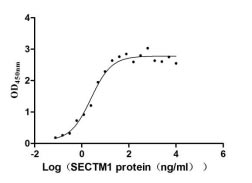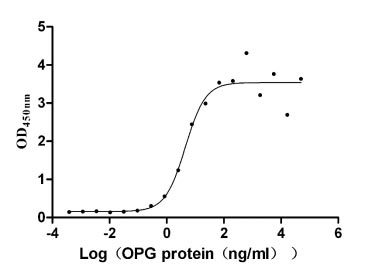Recombinant Human Calcium-binding and coiled-coil domain-containing protein 2 (CALCOCO2)
-
货号:CSB-YP614394HU
-
规格:
-
来源:Yeast
-
其他:
-
货号:CSB-EP614394HU-B
-
规格:
-
来源:E.coli
-
共轭:Avi-tag Biotinylated
E. coli biotin ligase (BirA) is highly specific in covalently attaching biotin to the 15 amino acid AviTag peptide. This recombinant protein was biotinylated in vivo by AviTag-BirA technology, which method is BriA catalyzes amide linkage between the biotin and the specific lysine of the AviTag.
-
其他:
-
货号:CSB-BP614394HU
-
规格:
-
来源:Baculovirus
-
其他:
-
货号:CSB-MP614394HU
-
规格:
-
来源:Mammalian cell
-
其他:
产品详情
-
纯度:>85% (SDS-PAGE)
-
基因名:
-
Uniprot No.:
-
别名:Antigen nuclear dot 52 kDa protein; CACO2_HUMAN; Calcium binding and coiled coil domain 2; Calcium binding and coiled coil domain containing protein 2; Calcium-binding and coiled-coil domain-containing protein 2; CALCOCO 2; CALCOCO2; MGC17318; NDP52; Nuclear domain 10 protein 52; Nuclear domain 10 protein; Nuclear domain 10 protein NDP52; Nuclear domain protein 52; Nuclear dot protein 52; OTTHUMP00000218344; OTTHUMP00000218345; OTTHUMP00000218346; OTTHUMP00000218347; OTTHUMP00000218349; OTTHUMP00000218351
-
种属:Homo sapiens (Human)
-
蛋白长度:full length protein
-
表达区域:1-446
-
氨基酸序列MEETIKDPPT SAVLLDHCHF SQVIFNSVEK FYIPGGDVTC HYTFTQHFIP RRKDWIGIFR VGWKTTREYY TFMWVTLPID LNNKSAKQQE VQFKAYYLPK DDEYYQFCYV DEDGVVRGAS IPFQFRPENE EDILVVTTQG EVEEIEQHNK ELCKENQELK DSCISLQKQN SDMQAELQKK QEELETLQSI NKKLELKVKE QKDYWETELL QLKEQNQKMS SENEKMGIRV DQLQAQLSTQ EKEMEKLVQG DQDKTEQLEQ LKKENDHLFL SLTEQRKDQK KLEQTVEQMK QNETTAMKKQ QELMDENFDL SKRLSENEII CNALQRQKER LEGENDLLKR ENSRLLSYMG LDFNSLPYQV PTSDEGGARQ NPGLAYGNPY SGIQESSSPS PLSIKKCPIC KADDICDHTL EQQQMQPLCF NCPICDKIFP ATEKQIFEDH VFCHSL
-
蛋白标签:Tag type will be determined during the manufacturing process.
The tag type will be determined during production process. If you have specified tag type, please tell us and we will develop the specified tag preferentially. -
产品提供形式:Lyophilized powder
Note: We will preferentially ship the format that we have in stock, however, if you have any special requirement for the format, please remark your requirement when placing the order, we will prepare according to your demand. -
复溶:We recommend that this vial be briefly centrifuged prior to opening to bring the contents to the bottom. Please reconstitute protein in deionized sterile water to a concentration of 0.1-1.0 mg/mL.We recommend to add 5-50% of glycerol (final concentration) and aliquot for long-term storage at -20℃/-80℃. Our default final concentration of glycerol is 50%. Customers could use it as reference.
-
储存条件:Store at -20°C/-80°C upon receipt, aliquoting is necessary for mutiple use. Avoid repeated freeze-thaw cycles.
-
保质期:The shelf life is related to many factors, storage state, buffer ingredients, storage temperature and the stability of the protein itself.
Generally, the shelf life of liquid form is 6 months at -20°C/-80°C. The shelf life of lyophilized form is 12 months at -20°C/-80°C. -
货期:Delivery time may differ from different purchasing way or location, please kindly consult your local distributors for specific delivery time.Note: All of our proteins are default shipped with normal blue ice packs, if you request to ship with dry ice, please communicate with us in advance and extra fees will be charged.
-
注意事项:Repeated freezing and thawing is not recommended. Store working aliquots at 4°C for up to one week.
-
Datasheet :Please contact us to get it.
相关产品
靶点详情
-
功能:Xenophagy-specific receptor required for autophagy-mediated intracellular bacteria degradation. Acts as an effector protein of galectin-sensed membrane damage that restricts the proliferation of infecting pathogens such as Salmonella typhimurium upon entry into the cytosol by targeting LGALS8-associated bacteria for autophagy. Initially orchestrates bacteria targeting to autophagosomes and subsequently ensures pathogen degradation by regulating pathogen-containing autophagosome maturation. Bacteria targeting to autophagosomes relies on its interaction with MAP1LC3A, MAP1LC3B and/or GABARAPL2, whereas regulation of pathogen-containing autophagosome maturation requires the interaction with MAP3LC3C. May play a role in ruffle formation and actin cytoskeleton organization and seems to negatively regulate constitutive secretion.
-
基因功能参考文献:
- Backfolding of MVI regulates its ability to bind DNA and that a putative transcription co-activator NDP52 relieves the auto-inhibition of MVI to enable DNA binding. Additionally, we show that the MVI-NDP52 complex binds RNAPII, which is critical for transcription, and that depletion of NDP52 or MVI reduces steady-state mRNA levels. PMID: 29187741
- findings reveal a negative feedback loop of RLR signaling generated by Tetherin-MARCH8-MAVS-NDP52 axis and provide insights into a better understanding of the crosstalk between selective autophagy and optimal deactivation of type I IFN signaling. PMID: 28965816
- The s propose that Rab35-GTP is a critical regulator of autophagy through recruiting autophagy receptor NDP52. PMID: 28848034
- The s identify calcium-binding and coiled-coil domain 2 (CALCOCO2, also known as NDP52) as a binding partner of influenza A virus PB1-F2. PMID: 28613140
- Presence of the NDP52 rs2303015 minor variant increases the risk for spontaneous bacterial peritonitis in patients with alcoholic cirrhosis. PMID: 26493630
- insight into how CALCOCO2 targets ubiquitin-decorated pathogens for autophagic degradations PMID: 26506893
- control retrotransposon insertion in the genome PMID: 25366815
- These data show that NDP52 promotes the maturation of autophagosomes via its interaction with LC3A, LC3B, and/or GABARAPL2 through a distinct LC3-interacting region, and with MYOSIN VI. PMID: 25771791
- data support a model in which non-ND10 resident Sp100 acts as a negative regulator of polycomb repressive complex-2 (PRC2) recruitment, and suggest that KSHV may actively escape ND10 silencing mechanisms to promote establishment of latent chromatin. PMID: 25033267
- the role of ORF75 in the antagonization of ND10-mediated intrinsic immunity PMID: 24453968
- Dimeric NDP52 forms a ternary complex with two monomeric galectin-8 molecules as well as two LC3C molecules PMID: 23511477
- The missense SNP rs2303015 (Val248Ala) in the NDP52 was associated with Crohn's disease. PMID: 23624108
- Data indicate that the binding site in galectin-8 is essential for the recruitment of the autophagy receptor NDP52 to cytosol-exposed Salmonella Typhimurium. PMID: 23386746
- Autophagy of Tax1bp1/Ndp52 promotes non-canonical NF-kappaB signalling. PMID: 23209807
- Data show that the selectivity of the autophagy receptor NDP52 for LC3C is crucial for innate immunity since cells lacking either protein cannot protect their PMID: 23022382
- Data show that the miRNA-processing enzyme, DICER and the main miRNA effector, AGO2, are targeted for degradation as miRNA-free entities PMID: 23143396
- a selective autophagic mechanism mediated by NDP52 that works downstream of TRIF-TRAF6. PMID: 21964925
- p62 and NDP52 act cooperatively to drive efficient antibacterial autophagy by targeting the protein complexes they coordinate to distinct microdomains associated with bacteria PMID: 21079414
- p62 and NDP52 proteins target intracytosolic Shigella and Listeria to different autophagy pathways. PMID: 21646350
- ND10 and ND10 components might be important defensive factors against the CMV cross-species infection PMID: 21552525
- interacts with ICP4 regulatory protein of HSV-1 during early stage of infection PMID: 14747555
- NDP52 was identified as a myosin VI binding protein; results suggest that myosin VI-T6BP-NDP52 complexes may play a role in coordinating cytokine signalling and membrane transport pathways with actin filament organisation and cell adhesion PMID: 17635994
- NDP52 recognizes ubiquitin-coated Salmonella enterica and recruits TBK1. PMID: 19820708
显示更多
收起更多
-
亚细胞定位:Cytoplasm, perinuclear region. Cytoplasm, cytoskeleton. Cytoplasmic vesicle, autophagosome membrane; Peripheral membrane protein.
-
蛋白家族:CALCOCO family
-
组织特异性:Expressed in all tissues tested with highest expression in skeletal muscle and lowest in brain.
-
数据库链接:
HGNC: 29912
OMIM: 604587
KEGG: hsa:10241
STRING: 9606.ENSP00000258947
UniGene: Hs.514920
Most popular with customers
-
Recombinant Human Secreted and transmembrane protein 1 (SECTM1), partial (Active)
Express system: Mammalian cell
Species: Homo sapiens (Human)
-
Recombinant Human Tumor necrosis factor receptor superfamily member 11B (TNFRSF11B) (Active)
Express system: Mammalian cell
Species: Homo sapiens (Human)
-
Recombinant Human Signal transducer CD24 (CD24)-Nanoparticle (Active)
Express system: Mammalian cell
Species: Homo sapiens (Human)
-
Recombinant Human Intestinal-type alkaline phosphatase (ALPI) (Active)
Express system: Mammalian cell
Species: Homo sapiens (Human)
-
Recombinant Mouse CUB domain-containing protein 1 (Cdcp1), partial (Active)
Express system: Mammalian cell
Species: Mus musculus (Mouse)
-
Recombinant Human C-C chemokine receptor type 9 (CCR9)-VLPs (Active)
Express system: Mammalian cell
Species: Homo sapiens (Human)
-
Recombinant Human Interleukin-1 receptor accessory protein (IL1RAP), partial (Active)
Express system: Mammalian cell
Species: Homo sapiens (Human)
-
Recombinant DT3C (Diphtheria toxin & spg 3C domain) for Antibody Internalization Assay (Active)
Express system: E.coli
Species: N/A




















